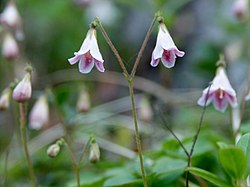

A subshrub (Latin suffrutex) or undershrub is either a small shrub (e.g. prostrate shrubs) or a perennial that is largely herbaceous but slightly woody at the base (e.g. garden pink and florist's chrysanthemum). The term is often interchangeable with "bush".
Because the criteria are matters of degree (normally of height) rather than of kind, the definition of a subshrub is not sharply distinguishable from that of a shrub; examples of reasons for describing plants as subshrubs include ground-hugging stems or low growth habit. Subshrubs may be largely herbaceous though still classified as woody, with overwintering perennial woody growth much lower-growing than deciduous summer growth. Some plants described as subshrubs are only weakly woody and some persist for only a few years. Others, such as Oldenburgia paradoxa live indefinitely (though is still vulnerable to external effects), rooted in rocky cracks.
Small, low shrubs such as lavender, periwinkle, and thyme, and many shrub-like members of the family Ericaceae, such as cranberries and small species of Erica, are often classed as subshrubs.
Definition
A chamaephyte, subshrub or dwarf-shrub is a plant that bears hibernating buds on persistent shoots near the ground – usually woody plants with perennating buds borne close to the ground, usually less than 25 centimetres (9.8 in) above the soil surface. The significance of the closeness to the ground is that the buds remain within the soil surface layer and are thus somewhat protected from various adverse external influences. Accordingly, the chamaephyte habit is especially common in stressful environments, for example:
- ecosystems on nutrient-poor soils or rock
- exposed alpine or arctic ecosystems where seasonal or perennial wind and freezing conditions are prone to kill vulnerable growing shoots
- ecosystems subject to frequent fires and burning, where many species of e.g. Banksia or Eucalyptus regrow from a lignotuber or caudex.
- heavily grazed or overgrazed ecosystems, such as tortoise turf
Examples of chamaephytes
The term chamaephyte is most formally used within the context of Raunkiær plant life-forms' classification. Examples of chamaephytes are many of the species living in the maquis shrubland and other plants of submediterranean dry ecosystems (species such as thyme, Thymus vulgaris, and rosemary, Salvia rosmarinus); others include heather species (e.g. Calluna vulgaris and Ericas), African wild olive (Olea europaea ssp. cuspidata) and edelweiss (Leontopodium alpinum). Chamaephytes also include cushion plants.
See also
References
- Harris, James G.; Harris, Melinda Woolf (2001). Plant identification terminology: an illustrated glossary (2nd ed.). Spring Lake, Utah: Spring Lake Publishing. p. 117.
- Jackson, Benjamin, Daydon; A Glossary of Botanic Terms with their Derivation and Accent; Published by Gerald Duckworth & Co. London, 4th ed 1928
- Raymond Louis Specht (1 February 1981). Heathlands and related shrublands: analytical studies. Elsevier Scientific Pub. Co. ISBN 9780444418098. Archived from the original on 2 April 2023. Retrieved 13 October 2016.
- Dennis M. Gorsuch; Steven F. Oberbauer; Jack B. Fisher; Dennis M. Gorsuch; Steven F. Oberbauer; Jack B. Fisher (2001), "Comparative Vessel Anatomy of Arctic Deciduous and Evergreen Dicots", American Journal of Botany, 88 (9): 1643–1649, doi:10.2307/3558409, JSTOR 3558409, PMID 21669698
- Fire in Mediterranean Ecosystems. Cambridge University Press. 2012. pp. 500–. ISBN 978-0-521-82491-0. Archived from the original on 2023-04-02. Retrieved 2016-10-13.
- Israel Journal of Botany. Weizmann Science Press of Israel. 1975. Archived from the original on 2023-04-02. Retrieved 2016-10-13.
- Molau, U.; Nordenhall, U.; Eriksen, B. (2005), "Onset of flowering and climate variability in an alpine landscape: a 10-year study from Swedish Lapland", American Journal of Botany, 92 (3): 422–31, doi:10.3732/ajb.92.3.422, PMID 21652418
| Botany | |||||||||||
|---|---|---|---|---|---|---|---|---|---|---|---|
| Subdisciplines | |||||||||||
| Plant groups | |||||||||||
| Plant anatomy |
| ||||||||||
| Plant physiology Materials | |||||||||||
| Plant growth and habit | |||||||||||
| Reproduction | |||||||||||
| Plant taxonomy | |||||||||||
| Practice | |||||||||||
| |||||||||||